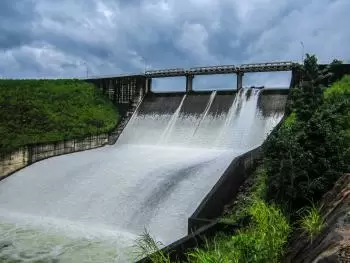
Hydropower is the energy obtained from the potential energy of the water or moving water. This energy can be directly harnessed to rotate the shaft of a hydraulic turbine for mechanical work.
It is a renewable energy source that depends on the water cycle. It is clean energy presented as an alternative to fossil fuels since it does not generate waste or greenhouse gases. However, it has some environmental impacts.
Hydroelectric power is the conversion of this mechanical work into electricity.
An advantage of hydroelectric power is that dams make it possible to regulate the river flow downstream past the barrier. On the other hand, among the many cons of hydraulic energy, the negative impact on the area’s ecosystem stands out.
{youtube:q8HmRLCgDAI}
How does hydropower work? Hydropower basics
Hydroelectric energy is due to the water flowing in rivers and lakes, thanks to dams and forced conduits.
There are several types of hydropower plants:
-
Stations that have significant drop heights - in the mountain regions.
-
Stations that have small height differences - fluid water plants and large river water masses.
Water from a lake or artificial basin is transported downstream through penstocks. In this way, its potential energy and kinetic energy are transformed, which can be used in multiple ways.
The energy obtained can have two functions:
-
Perform mechanical work (for example, in industrial processes)
-
To produce electrical energy (it is the most common use)
Power plants use mechanical energy to drive a hydraulic turbine connected to an electrical generator and then produce electricity.
Tidal power
Hydropower production can also take place through the exploitation of waves, tides, and ocean currents. In this case, we are talking about tidal energy or tidal energy.
Examples of hydropower
When we talk about hydropower, we often refer to electrical power. However, it has many applications:
-
A hydroelectric plant is capable of converting hydropower into electricity.
-
A surfer driven by the waves acquires kinetic energy thanks to the sea’s hydraulic energy.
-
A kayak going down the river’s rapids takes advantage of the river’s current to carry out displacement work.
-
A watermill converts falling water into rotational energy. Hydraulic mills have been used throughout history. They were popular in activities related to agriculture (production of flour and oil) and in the industry (metal, paper, or textile).
Some examples of significant hydroelectric plants are:
-
The Robert Moses Niagara Power Plant, located near Niagara Falls in the United States, was the first hydroelectric plant in history.
-
On the border between Paraguay and Brazil, there is the Itaipu hydroelectric plant. It is the largest hydroelectric power plant in terms of power generated.
-
The Three Gorges Dam (China) is the second-largest dam in the world.
How does a hydroelectric plant work?
Hydropower is the application of hydraulic energy to generate electricity.
Hydroelectric plants can include a reservoir, usually creating a dam, regulating the flow, and exploiting the falling water’s energy. They can also use the kinetic energy of water as in the hydroelectricity of the river current.
A turbine and generator produce electricity.
Hydroelectric power station
A hydroelectric plant is a set of hydraulic engineering works and machines to obtain electricity from the force of water.
The water is transported to one or more hydraulic turbines that rotate thanks to the water’s pressure. Each turbine is coupled to an alternator that transforms the rotational movement into electrical energy.
What is pumped-storage hydroelectricity (PSH)?
Hydropower can also store energy in the form of potential energy between two reservoirs at different heights. It is a method of hydroelectric energy to keep by electric power systems for load balancing.
When there is surplus power, the plant pumps water into the upper reservoir.
When there is demand, the water is released to drive the turbines again.
Disadvantages of hydroelectric plants
Even though this source is considered clean energy, its use implies considerable advantages to other non-renewable energy types. However, there are certain drawbacks:
To build a hydroelectric power station involves:
-
To build hydroelectric dams and large basins or artificial deposits.
-
To build a dam implies the flooding of expansive soils.
-
It alters the river flow.
-
It affects the path of the sediments transported by the river.
These problems have a particular impact. In severe cases, it can disrupt the area’s ecosystem with significant environmental damage and risks.